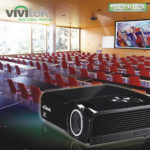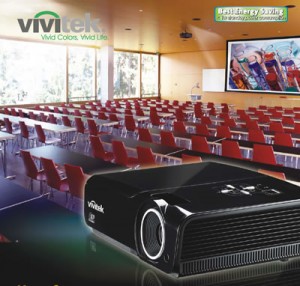
Blonder Tongue Laboratories displayed its DVS-400 video server designed for broadcasting applications, which the company said is essentially a digital “TV station-in-a-box.” The server stores hundreds of hours of video content and uses software with a graphical interface to schedule video broadcasts as desired.
Calypso Systems showcased its integrated school communication systems at Florida’s technology demonstration school, Ocoee Middle School. Ocoee uses three Calypso ezRoom-5000 classroom audio-visual systems, complete with integrated voice amplification capabilities. With help from the Florida State Legislature and the Orange County Public Schools, Ocoee Middle School underwent a top-to-bottom renovation in 2009, transforming the school into a showcase for technology-based learning enhancements. The school is designed with 21st-century instruction in mind, incorporating ceiling-mounted projectors, document cameras, and large screens in every classroom. Designed specifically for the K-12 classroom, Calypso’s ezRoom-5000 brings together multiple AV sources—such as projectors, interactive whiteboards, document cameras, and personal computers—and gives teachers a single point of control for them all, accessible from a wall controller and the teacher’s PC. It also provides an integrated wireless voice amplification system.
Mediatech introduced a configurable button panel to control AV equipment, including projectors, screens, and document cameras. Features include the ability to control RS-232 and infrared devices, an add-on LAN module, interchangeable button labels, seven user-controlled LED colors, audible tones, command scripting with auto power-up and shutdown, a security lockout option, and two serial and one IR control ports.
RoomPro Technologies released RoomPro ONE, an integrated, all-in-one classroom audio-visual control and sound amplification system. RoomPro ONE is equipped with a built-in infrared microphone system that offers voice enhancement and 360-degree sound reinforcement, the company said. It also includes a wall panel for simple, one-touch control of AV equipment, as well as a Virtual Control Panel, proprietary emulation software that allows teachers to operate the system using multiple instructional technologies.
Samsung introduced its SDP-860 Digital Presenter, which the company calls a high-quality system priced with education in mind. It has the ability to record up to 32 gigabytes of data via an SDHC memory card, and it can capture and display high-resolution still shots as well as movies with full audio. It also can record audio at any time. User-scalable display outputs range from XGA to full HD resolution, and the native SXGA resolution at 30 frames per second provides full-motion display with no latency. The SDP-860 also has multiple joints to allow for easy movement.
Sanyo showcased its PDG-DXL100 and PDG-DWL100 short-throw and wide short-throw projectors geared for education. These small DLP projectors are good for tight spaces and offer 2,700 and 2,600 lumens of brightness, respectively. The PDG-DXL100 features XGA (1,024 x 768) resolution, and the PDG-DWL100 features WXGA (1,280 x 800) resolution. Both systems come with built-in 8x speakers, an HDMI input, and an RJ-45 LAN port for network control, and they weigh just over eight pounds.
Texas Instruments DLP exhibited a variety of 3D-ready projectors using the company’s single-projector technology. 3D-ready DLP projectors from BenQ, InFocus, Mitsubishi, Optoma, ViewSonic, and Vivitek are currently available, and Acer, Dell, NEC, and Sharp will be shipping 3D-ready projectors for the education market soon. TI DLP also is working with content providers to deliver interactive 3D content for teaching various topics ranging from science to art. JTM Concepts recently conducted independent studies in the state of Illinois to compare the results of grade school classes taught with a 3D curriculum versus standard teaching methods. The research, supported by state funding, showed that students taught using one of JTM’s Classroom3 3D simulations had an average test-score increase of up to 35 percent, compared with a 9.8-percent average increase from traditional teaching methods.
- #4: 25 education trends for 2018 - December 26, 2018
- Video of the Week: Dealing with digital distraction in the classroom - February 23, 2018
- Secrets from the library lines: 5 ways schools can boost digital engagement - January 2, 2018


